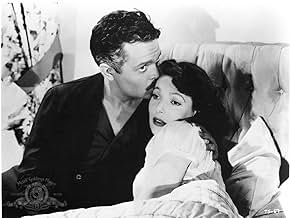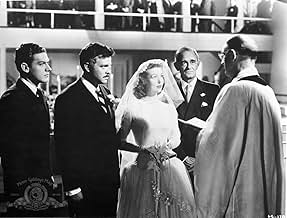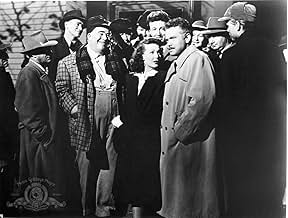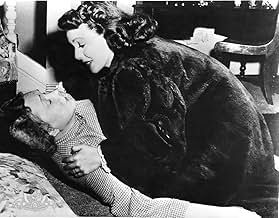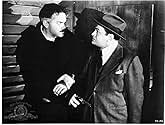An investigator from the War Crimes Commission travels to Connecticut to find an infamous Nazi.An investigator from the War Crimes Commission travels to Connecticut to find an infamous Nazi.An investigator from the War Crimes Commission travels to Connecticut to find an infamous Nazi.
- Nominated for 1 Oscar
- 2 nominations total
David Bond
- Student
- (uncredited)
John Brown
- Passport Photographer
- (uncredited)
Nancy Evans
- Undetermined Role
- (uncredited)
Adolph Faylauer
- War Crimes Commision Member
- (uncredited)
Fred Godoy
- Undetermined Role
- (uncredited)
Theodore Gottlieb
- Fairbright
- (uncredited)
Joseph Granby
- Undetermined Role
- (uncredited)
Ethan Laidlaw
- Todd
- (uncredited)
Featured reviews
The IMDb trivia page says this is Orson Welles's least favorite and least personal film. Aside from "Citizen Kane" and "The Magnificent Ambersons," I think this potent film noir is his most enjoyable—certainly more so than the ugly "Lady from Shanghai" or the overbaked and convoluted "Touch of Evil."
Charles Rankin (Orson Welles) is a professor in a respectable Connecticut town about to marry the daughter of a U.S. Supreme Court justice. But his name is fake and his past is filthy. An earnest convert to Christianity (Konstantin Shayne), who once ran a Nazi concentration camp, is capable of exposing him. "Rankin" kills this little old man and buries his body in the forest. But he isn't safe because an investigator (Edward G. Robinson) from the War Crimes Commission is on his tail. Rankin needs his own wife (Loretta Young) to help him elude capture. But his fascination with the local clock tower may prove his undoing.
As a director, Welles strains a bit too hard for effect in this film—and much too hard in everything but "Kane" and "Ambersons." In those two films all of his technical effects, striking as they are, seem effortless and exactly the right choices. Here, he has imperfect moments—such as the scene where his character is frantically, and inexplicably, trying to pick up pieces of paper—but everything else is splendid, especially the climax.
As an actor he's always compelling, but I think he makes one bad choice here. He's too guilty-looking in the early scenes. It makes us wonder why no one suspects him; and it robs us of a dramatic contrast when he begins to realize he's in imminent danger.
Loretta Young is generally a dull actress. She doesn't have enough skill to make an impression in the early scenes; but once the part requires histrionics she performs her duties well enough. Certainly her character is morally dubious and therefore fascinating in itself.
The best performance by far is Edward G. Robinson's. One of the great actors of his time, this ugly man has enough talent and star quality to underplay his role to great effect.
Orson Welles fans might find this exciting, well-plotted thriller too un-Wellesian to suit them. Otherwise, this is highly recommended.
Charles Rankin (Orson Welles) is a professor in a respectable Connecticut town about to marry the daughter of a U.S. Supreme Court justice. But his name is fake and his past is filthy. An earnest convert to Christianity (Konstantin Shayne), who once ran a Nazi concentration camp, is capable of exposing him. "Rankin" kills this little old man and buries his body in the forest. But he isn't safe because an investigator (Edward G. Robinson) from the War Crimes Commission is on his tail. Rankin needs his own wife (Loretta Young) to help him elude capture. But his fascination with the local clock tower may prove his undoing.
As a director, Welles strains a bit too hard for effect in this film—and much too hard in everything but "Kane" and "Ambersons." In those two films all of his technical effects, striking as they are, seem effortless and exactly the right choices. Here, he has imperfect moments—such as the scene where his character is frantically, and inexplicably, trying to pick up pieces of paper—but everything else is splendid, especially the climax.
As an actor he's always compelling, but I think he makes one bad choice here. He's too guilty-looking in the early scenes. It makes us wonder why no one suspects him; and it robs us of a dramatic contrast when he begins to realize he's in imminent danger.
Loretta Young is generally a dull actress. She doesn't have enough skill to make an impression in the early scenes; but once the part requires histrionics she performs her duties well enough. Certainly her character is morally dubious and therefore fascinating in itself.
The best performance by far is Edward G. Robinson's. One of the great actors of his time, this ugly man has enough talent and star quality to underplay his role to great effect.
Orson Welles fans might find this exciting, well-plotted thriller too un-Wellesian to suit them. Otherwise, this is highly recommended.
Stylish noir trading on public's concern with escaped Nazis following WWII. First part is especially intriguing since we can't be sure what's happening or who Franz Kindler is. The atmosphere is typically Wellesian— shadows galore, imaginative camera set-ups, along with dramatic use of sound. Two features, however, standout for me.
Once the plot comes into focus, we know Kindler (Welles) must do away with Meinicke (Shayne), but how. The forest scene is inspired, more menacing I think than the finale. The two men are on bended knee, in apparent communion with the forces of good, except one of them is not.
Second is Welles' depiction of small town America through druggist Potter (House, in a splendid performance). Grossly over-weight, he sits all day in front of his checkerboard, hoping to entice some sucker into a game, so he can cheat them out of a quarter. Worse, he makes customers serve themselves, apparently so he won't have to move his bulk. Not exactly the neighborly small town of Shadow of a Doubt (1943), for example.
Given the movie's many arresting features, I'm not sure why its profile isn't higher among both noirs and the Welles canon. My best guess concerns a general absence of ambiguity among both characters and situations. Instead, the screenplay is a straight pursuit film of good vs. evil that makes good use of cat and mouse, and of atmosphere, but is unexceptional in storyline. So if you're looking for stylish suspense without tricky moral complications, this is a movie to catch.
Once the plot comes into focus, we know Kindler (Welles) must do away with Meinicke (Shayne), but how. The forest scene is inspired, more menacing I think than the finale. The two men are on bended knee, in apparent communion with the forces of good, except one of them is not.
Second is Welles' depiction of small town America through druggist Potter (House, in a splendid performance). Grossly over-weight, he sits all day in front of his checkerboard, hoping to entice some sucker into a game, so he can cheat them out of a quarter. Worse, he makes customers serve themselves, apparently so he won't have to move his bulk. Not exactly the neighborly small town of Shadow of a Doubt (1943), for example.
Given the movie's many arresting features, I'm not sure why its profile isn't higher among both noirs and the Welles canon. My best guess concerns a general absence of ambiguity among both characters and situations. Instead, the screenplay is a straight pursuit film of good vs. evil that makes good use of cat and mouse, and of atmosphere, but is unexceptional in storyline. So if you're looking for stylish suspense without tricky moral complications, this is a movie to catch.
Infamous Nazi war criminal called Franz Kindler (Orson Welles) assumes a new respectable identity in a Midwestern little town following WWII , unaware that a government agent (Edward G. Robinson) from the Allied War Crimes commission patiently stalks him . But his name is fake and his past is tenebrous . The escaped Nazi sedately living and is about to marry a beautiful as well as unsuspecting young woman (Loretta Young) , daughter of a prestigious judge (Philip Merivale) . But later on , Kindler feels his past closing in and he will need his own spouse to help him elude capture .
Interesting Welles movie with plenty of thrills , fine character studio , terrific interpretations and suspense from start to finish . It holds the viewer's interest but admittedly has some flaws , naive moments and wobbles . But it is studded with splendid scenes like the furtive flight across the dockyards at the beginning , the killing in the forests and the final confrontation on the clock tower including the sword wielded mechanical figures that move when the hour begins to strike . The vast New England town exterior sets, including the church with its 124-foot clock tower, were constructed in Hollywood on the back lot of the United Artists studio located on Santa Monica Blvd . Shocking scenes when are shown images about Nazi crimes , in fact it was the first mainstream American movie to feature footage of Nazi concentration camps following World War II . Nice acting by Orson Welles as a Nazi criminal who feels fascination with antique clocks and sedately esconsced in a small Connecticut town when an investigator is tailing him . Edward G. Robinson is perfect as a Federal agent out to get him . However , Orson Welles originally wanted Agnes Moorehead to play the FBI part , then the studio said no and instead gave him Edward G. Robinson . Furthermore , Loretta Young as attractive wife and Richard Long as brother give nicely understated interpretations . Suspenseful and thrilling musical score by Bronislau Kaper . Extremely well made camera-work throughout ; being shot in black and white filled with lights and darks by excellent cameraman Russell Metty . It is also available in horrible computer-colored version .
¨The stranger¨ was efficiently produced by Sam Spiegel and well directed by Orson Welles in 95 minutes runtime , being the only film directed by him to show a profit in its original release . However , Orson has stated that this is his least favorite of his films . Welles was a genius who had a large as well as problematic career . In 1938 he produced "The Mercury Theatre on the Air", famous for its broadcast version of "The War of the Worlds" . His first film to be seen by the public was ¨Ciudadano Kane¨ (1941), a commercial failure , but regarded by many as the best film ever made , along with his following movie , ¨The magnificent Ambersons¨ . After that , he directed this ¨The stranger¨ with an over-pitched acting by the same Welles and often described as his worst . He subsequently directed Shakespeare adaptation such as ¨Macbeth¨ , ¨Othelo¨ and his highly enjoyable ¨Chimes at Midnight¨ or ¨Falstaff¨ . He also performed a lot of films , Orson Welles interpreted for getting financing to shoot his pictures , as he played several exotic characters such as ¨The Tartari¨ , ¨Saul¨ , ¨Cagliostro¨ , ¨Cesare Borgia¨ and ¨Black rose¨ . Many of his next films were commercial flops and he exiled himself to Europe in 1948 . In 1956 he directed ¨Touch of evil¨ (1958) ; it failed in the U.S. but won a prize at the 1958 Brussels World's Fair . In 1975, in spite of all his box-office failures , he received the American Film Institute's Lifetime Achievement Award , and in 1984 the Directors Guild of America awarded him its highest honor, the D.W. Griffith Award . His reputation as a film maker has climbed steadily ever since .
Interesting Welles movie with plenty of thrills , fine character studio , terrific interpretations and suspense from start to finish . It holds the viewer's interest but admittedly has some flaws , naive moments and wobbles . But it is studded with splendid scenes like the furtive flight across the dockyards at the beginning , the killing in the forests and the final confrontation on the clock tower including the sword wielded mechanical figures that move when the hour begins to strike . The vast New England town exterior sets, including the church with its 124-foot clock tower, were constructed in Hollywood on the back lot of the United Artists studio located on Santa Monica Blvd . Shocking scenes when are shown images about Nazi crimes , in fact it was the first mainstream American movie to feature footage of Nazi concentration camps following World War II . Nice acting by Orson Welles as a Nazi criminal who feels fascination with antique clocks and sedately esconsced in a small Connecticut town when an investigator is tailing him . Edward G. Robinson is perfect as a Federal agent out to get him . However , Orson Welles originally wanted Agnes Moorehead to play the FBI part , then the studio said no and instead gave him Edward G. Robinson . Furthermore , Loretta Young as attractive wife and Richard Long as brother give nicely understated interpretations . Suspenseful and thrilling musical score by Bronislau Kaper . Extremely well made camera-work throughout ; being shot in black and white filled with lights and darks by excellent cameraman Russell Metty . It is also available in horrible computer-colored version .
¨The stranger¨ was efficiently produced by Sam Spiegel and well directed by Orson Welles in 95 minutes runtime , being the only film directed by him to show a profit in its original release . However , Orson has stated that this is his least favorite of his films . Welles was a genius who had a large as well as problematic career . In 1938 he produced "The Mercury Theatre on the Air", famous for its broadcast version of "The War of the Worlds" . His first film to be seen by the public was ¨Ciudadano Kane¨ (1941), a commercial failure , but regarded by many as the best film ever made , along with his following movie , ¨The magnificent Ambersons¨ . After that , he directed this ¨The stranger¨ with an over-pitched acting by the same Welles and often described as his worst . He subsequently directed Shakespeare adaptation such as ¨Macbeth¨ , ¨Othelo¨ and his highly enjoyable ¨Chimes at Midnight¨ or ¨Falstaff¨ . He also performed a lot of films , Orson Welles interpreted for getting financing to shoot his pictures , as he played several exotic characters such as ¨The Tartari¨ , ¨Saul¨ , ¨Cagliostro¨ , ¨Cesare Borgia¨ and ¨Black rose¨ . Many of his next films were commercial flops and he exiled himself to Europe in 1948 . In 1956 he directed ¨Touch of evil¨ (1958) ; it failed in the U.S. but won a prize at the 1958 Brussels World's Fair . In 1975, in spite of all his box-office failures , he received the American Film Institute's Lifetime Achievement Award , and in 1984 the Directors Guild of America awarded him its highest honor, the D.W. Griffith Award . His reputation as a film maker has climbed steadily ever since .
I picked up this movie, mostly because of the cover and the price ($4). I was happily surprised as to the quality of the movie.
The story takes place after the end of World War II. Edward G. Robinson plays a government official named Mr. Wilson. He is in charge of the Allied War Crime commission. He is looking for an elusive war criminal. His name is Franz Kindler (Orson Welles). He is suppose to be the one who came up with the Nazi plan of mass annihilation. There is no evidence, nor any photographs of Kindler. To find Franz, Wilson releases Kindler's assistant (Konrad). Konrad inadvertently leads Wilson to Harper, Connecticut. Kindler is hiding out at an all boys school as a professor named Charles Rankin. Konrad arrives on Charles' wedding day. He is getting married to the daughter of a liberal Supreme Court justice.
This movie is definitely film noir, in the lighting and the grittiness of the events. It is also quite evident that this movie was directed by Welles himself. If you have seen any one of his movies, you can see how he functions. The story is enjoyable, if not slightly predictable (especially if you have seen other film noir films or have listened to any golden age radio programs). Overall, it is nice to see Edward G. Robinson playing the good guy for a change. I also thought Billy House had a standout performance as Mr. Potter (the owner of the local general store). He provides most of the comedy relief. I highly recommend this movie for fans of Edward G. Robinson, Welles or the film noir genre.
-Celluloid Rehab
The story takes place after the end of World War II. Edward G. Robinson plays a government official named Mr. Wilson. He is in charge of the Allied War Crime commission. He is looking for an elusive war criminal. His name is Franz Kindler (Orson Welles). He is suppose to be the one who came up with the Nazi plan of mass annihilation. There is no evidence, nor any photographs of Kindler. To find Franz, Wilson releases Kindler's assistant (Konrad). Konrad inadvertently leads Wilson to Harper, Connecticut. Kindler is hiding out at an all boys school as a professor named Charles Rankin. Konrad arrives on Charles' wedding day. He is getting married to the daughter of a liberal Supreme Court justice.
This movie is definitely film noir, in the lighting and the grittiness of the events. It is also quite evident that this movie was directed by Welles himself. If you have seen any one of his movies, you can see how he functions. The story is enjoyable, if not slightly predictable (especially if you have seen other film noir films or have listened to any golden age radio programs). Overall, it is nice to see Edward G. Robinson playing the good guy for a change. I also thought Billy House had a standout performance as Mr. Potter (the owner of the local general store). He provides most of the comedy relief. I highly recommend this movie for fans of Edward G. Robinson, Welles or the film noir genre.
-Celluloid Rehab
The Stranger was directed by Orson Welles but he did not adapt it to the screen. Although this is seen as a detraction from the whole by some who have seen it, I believe that Welles' deft directing and penetrating acting is what makes this a Welles film for my taste. He was never a facile actor - but he uses his usual wooden countenance here to the advantage of this role.
Another thing that fascinates me is the underrated status of this engrossing thriller. The action and suspense builds and builds to a peak of excitement that few movies can reach without lots of special effects and Foley work these days. This movie fascinates at every turn without ever seeming as if we are watching art. But art it was in Welles' direction and gentle handling of the unravelling.
Edward G. Robinson is the subtle but welcome prize we receive from this outing. The undercurrents of the horrors that have just come before this movie was made and its actions can be seen seething within his duty to find hidden Nazis. He is methodical and intelligent, it so difficult to see the difference between Robinson the man and Robinson the actor here. He is such a talent that we often mistake his ease for something else but acting -- and of acting he was a master. Plainly seen here as a gift to all of us.
What I like about this and many other good films is how facts are revealed slowly, layer by layer.
Loretta Young was good as the innocent young girl who believes that marriage is a sacred institution, that life has a course to follow which will not be derailed and finds it hard to accept the truth of the horrors behind her marriage.
It was mildly amusing to see a very young Richard Long as the open-minded young man with whom Robinson's character confides certain facts.
I recommend it to fans of psychological thrillers, mysteries and of course, of Mr. Orson Welles. So sad that the studio heads were such disingenuous towards this utter genius of a man who deserved more earnest accolades in his life.
THE STRANGER is not glittering masterpiece but it's a hell of great story that I do not tire of watching...and seeing each piece of the puzzle fall into place.
What MORE could an intelligent person want from a movie?
Another thing that fascinates me is the underrated status of this engrossing thriller. The action and suspense builds and builds to a peak of excitement that few movies can reach without lots of special effects and Foley work these days. This movie fascinates at every turn without ever seeming as if we are watching art. But art it was in Welles' direction and gentle handling of the unravelling.
Edward G. Robinson is the subtle but welcome prize we receive from this outing. The undercurrents of the horrors that have just come before this movie was made and its actions can be seen seething within his duty to find hidden Nazis. He is methodical and intelligent, it so difficult to see the difference between Robinson the man and Robinson the actor here. He is such a talent that we often mistake his ease for something else but acting -- and of acting he was a master. Plainly seen here as a gift to all of us.
What I like about this and many other good films is how facts are revealed slowly, layer by layer.
Loretta Young was good as the innocent young girl who believes that marriage is a sacred institution, that life has a course to follow which will not be derailed and finds it hard to accept the truth of the horrors behind her marriage.
It was mildly amusing to see a very young Richard Long as the open-minded young man with whom Robinson's character confides certain facts.
I recommend it to fans of psychological thrillers, mysteries and of course, of Mr. Orson Welles. So sad that the studio heads were such disingenuous towards this utter genius of a man who deserved more earnest accolades in his life.
THE STRANGER is not glittering masterpiece but it's a hell of great story that I do not tire of watching...and seeing each piece of the puzzle fall into place.
What MORE could an intelligent person want from a movie?
Did you know
- TriviaThis was the first mainstream American movie to feature footage of Nazi concentration camps following World War II.
- GoofsTwo palm trees are visible in the first scene depicting the fictional Connecticut town.
- Quotes
Mr. Wilson: Well, who but a Nazi would deny that Karl Marx was a German because he was a Jew?
- Alternate versionsAlso available in a computer-colorized version.
- ConnectionsEdited into Ninja the Mission Force: Citizen Ninja (2012)
Details
Box office
- Budget
- $1,034,000 (estimated)
- Runtime1 hour 35 minutes
- Color
- Aspect ratio
- 1.37 : 1
Contribute to this page
Suggest an edit or add missing content




